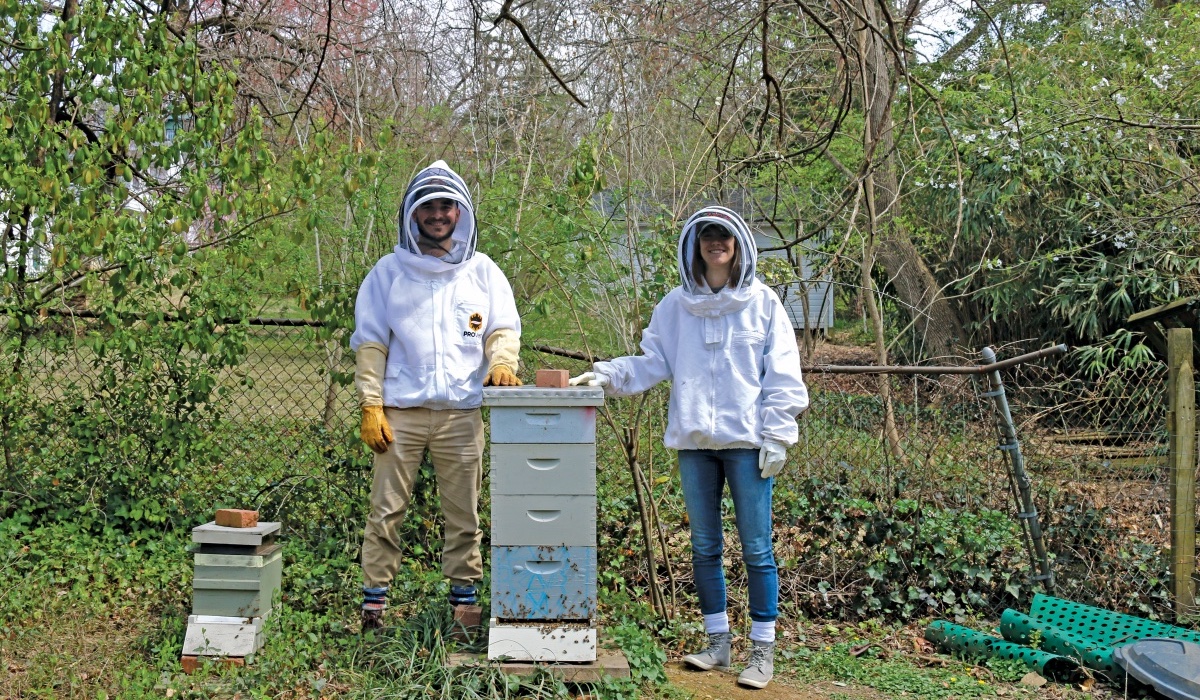

A beehive tracking device designed by Catholic University engineering alumni while they were graduate students has now been in use by a local beekeeper for more than two years. The monitoring system, which was built by Anna Stumme, B.E.E. 2017, M.S. 2019, and Brett Padula, B.M.E. 2017, M.S. 2019, was part of a project for the pair’s Social Innovations course, taught by Greg Behrmann, Ph.D. 2009, a clinical associate professor of engineering, with part-time associate professor and Ciocca Center Fellow Chris Danek, B.M.E. 1989.
Every year, students in the course are tasked with building a company around a product and reaching out to consumers who would be willing to share their feedback. The goal is to design something user-friendly that will solve a real-world problem.
The idea for a project related to beekeeping came from Behrmann, who was interested in beehive monitoring after learning about the dangerous decline in bees around the world. He suggested Stumme and Padula take up the challenge and encouraged them to reach out to the D.C. Beekeepers Association for more guidance.
Both Stumme and Padula had previously earned their bachelor’s degrees in engineering from CatholicU while also competing as student-athletes. The students connected with Frank Linton, an engineer-turned-beekeeper who lives in Maryland. Linton was interested in learning more about the hive temperature because healthy bees naturally keep their brood at a certain temperature.
“You can tell quite a lot from the temperature,” he said. “If you had a whole array of temperature sensors in the hive, you could tell more about the brood, including how large it is, how much it is growing or shrinking, and where they are in the hive — are they up by the honey or down below?”
The system designed by Stumme and Padula consists of a grid of 36 temperature sensors embedded in a wooden panel. The setup, which runs 24 hours a day and records data to an SD card, is designed to slide between beehive components and is in place all year long.
Linton checks the sensors every two weeks to collect the data and change the batteries. While there are other places that sell sensors, Linton believes the system designed by Stumme and Padula might be the best one. Linton presented his findings using the sensor system as part of a three-part series in the American Bee Journal and at an international conference.
“It really is a groundbreaking system that has the potential to give a lot more detail of what’s going on in a beehive than conventional systems do,” Linton said.
Even though they have both since graduated and now work full time (Stumme at the Naval Research Laboratory and Padula at the Army Research Laboratory), Stumme and Padula continue working on the project. They check on the system a few times a year to make updates and ensure that it is still working properly. Stumme, who is in a doctoral program in electrical engineering at Penn State, says she enjoys being able to work creatively on a project that is so different from her day-to-day work.
“I’ve done more of the programming for the microcontroller we use for the temperature sensor, which hasn’t always been my strong suit,” she said. “It’s something I wouldn’t have seen myself doing, just rolling with the unknown like this.”
Padula said he’s also enjoyed the creative aspect of working with the beehive monitoring system.
“It’s different from what I do at work,” he said. “It’s interesting to see how you might build a project from the ground up."
— K.B.